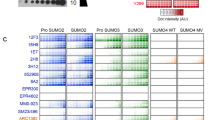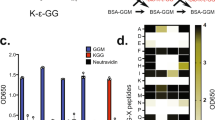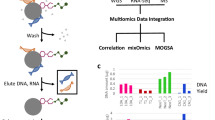Abstract
SUMOylation is a protein modification that regulates the function of hundreds of proteins. Detecting endogenous SUMOylation is challenging: most small ubiquitin-related modifier (SUMO) targets are low in abundance, and only a fraction of a protein's cellular pool is typically SUMOylated. Here we present a step-by-step protocol for the enrichment of endogenous SUMO targets from mammalian cells and tissues (specifically, mouse liver), based on the use of monoclonal antibodies that are available to the scientific community. The protocol comprises (i) production of antibodies and affinity matrix, (ii) denaturing cell lysis, and (iii) SUMO immunoprecipitation followed by peptide elution. Production of affinity matrix and cell lysis requires ∼1 d. The immunoprecipitation with peptide elution can be performed in 2 d. As SUMO proteins are conserved, this protocol should also be applicable to other organisms, including many vertebrates and Drosophila melanogaster.
This is a preview of subscription content, access via your institution
Access options
Subscribe to this journal
Receive 12 print issues and online access
$259.00 per year
only $21.58 per issue
Buy this article
- Purchase on Springer Link
- Instant access to full article PDF
Prices may be subject to local taxes which are calculated during checkout




Similar content being viewed by others
References
Flotho, A. & Melchior, F. SUMOylation: a regulatory protein modification in health and disease. Annu. Rev. Biochem. 82, 357–385 (2013).
Jentsch, S. & Psakhye, I. Control of nuclear activities by substrate-selective and protein-group SUMOylation. Annu. Rev. Genet. 47, 167–186 (2013).
Gareau, J.R. & Lima, C.D. The SUMO pathway: emerging mechanisms that shape specificity, conjugation and recognition. Nat. Rev. Mol. Cell Biol. 11, 861–871 (2010).
Cubenas-Potts, C. & Matunis, M.J. SUMO: a multifaceted modifier of chromatin structure and function. Dev. Cell 24, 1–12 (2013).
Hickey, C.M., Wilson, N.R. & Hochstrasser, M. Function and regulation of SUMO proteases. Nat. Rev. Mol. Cell Biol. 13, 755–766 (2012).
Hecker, C.M., Rabiller, M., Haglund, K., Bayer, P. & Dikic, I. Specification of SUMO1- and SUMO2-interacting motifs. J. Biol. Chem. 281, 16117–16127 (2006).
Song, J., Durrin, L.K., Wilkinson, T.A., Krontiris, T.G. & Chen, Y. Identification of a SUMO-binding motif that recognizes SUMO-modified proteins. Proc. Natl. Acad. Sci. USA 101, 14373–14378 (2004).
Song, J., Zhang, Z., Hu, W. & Chen, Y. Small ubiquitin-like modifier (SUMO) recognition of a SUMO binding motif: a reversal of the bound orientation. J. Biol. Chem. 280, 40122–40129 (2005).
Watts, F.Z. Starting and stopping SUMOylation: What regulates the regulator? Chromosoma 122, 451–463 (2013).
Da Silva-Ferrada, E., Lopitz-Otsoa, F., Lang, V., Rodriguez, M.S. & Matthiesen, R. Strategies to identify recognition signals and targets of SUMOylation. Biochem. Res. Int. 2012, 875148 (2012).
Filosa, G., Barabino, S.M. & Bachi, A. Proteomics strategies to identify SUMO targets and acceptor sites: a survey of RNA-binding proteins SUMOylation. Neuromolecular. Med. 15, 661–676 (2013).
Desterro, J.M., Rodriguez, M.S. & Hay, R.T. SUMO-1 modification of IκBα inhibits NF-κB activation. Mol. Cell 2, 233–239 (1998).
Mahajan, R., Gerace, L. & Melchior, F. Molecular characterization of the SUMO-1 modification of RanGAP1 and its role in nuclear envelope association. J. Cell Biol. 140, 259–270 (1998).
Rodriguez, M.S. et al. SUMO-1 modification activates the transcriptional response of p53. EMBO J. 18, 6455–6461 (1999).
Sternsdorf, T., Jensen, K., Reich, B. & Will, H. The nuclear dot protein sp100, characterization of domains necessary for dimerization, subcellular localization, and modification by small ubiquitin-like modifiers. J. Biol. Chem. 274, 12555–12566 (1999).
Pichler, A. et al. SUMO modification of the ubiquitin-conjugating enzyme E2-25K. Nat. Struct. Mol. Biol. 12, 264–269 (2005).
Rodriguez, M.S., Dargemont, C. & Hay, R.T. SUMO-1 conjugation in vivo requires both a consensus modification motif and nuclear targeting. J. Biol. Chem. 276, 12654–12659 (2001).
Denison, C. et al. A proteomic strategy for gaining insights into protein SUMOylation in yeast. Mol. Cell Proteomics 4, 246–254 (2005).
Panse, V.G., Hardeland, U., Werner, T., Kuster, B. & Hurt, E. A proteome-wide approach identifies SUMOylated substrate proteins in yeast. J. Biol. Chem. 279, 41346–41351 (2004).
Zhou, W., Ryan, J.J. & Zhou, H. Global analyses of SUMOylated proteins in Saccharomyces cerevisiae. Induction of protein SUMOylation by cellular stresses. J. Biol. Chem. 279, 32262–32268 (2004).
Nie, M., Xie, Y., Loo, J.A. & Courey, A.J. Genetic and proteomic evidence for roles of Drosophila SUMO in cell cycle control, Ras signaling, and early pattern formation. PLoS ONE 4, e5905 (2009).
Kaminsky, R. et al. SUMO regulates the assembly and function of a cytoplasmic intermediate filament protein in C. elegans. Dev. Cell 17, 724–735 (2009).
Miller, M.J., Barrett-Wilt, G.A., Hua, Z. & Vierstra, R.D. Proteomic analyses identify a diverse array of nuclear processes affected by small ubiquitin-like modifier conjugation in Arabidopsis. Proc. Natl. Acad. Sci. USA 107, 16512–16517 (2010).
Tirard, M. et al. In vivo localization and identification of SUMOylated proteins in the brain of His6-HA-SUMO1 knock-in mice. Proc. Natl. Acad. Sci. USA 109, 21122–21127 (2012).
Vertegaal, A.C. et al. Distinct and overlapping sets of SUMO-1 and SUMO-2 target proteins revealed by quantitative proteomics. Mol. Cell Proteomics 5, 2298–2310 (2006).
Vertegaal, A.C. et al. A proteomic study of SUMO-2 target proteins. J. Biol. Chem. 279, 33791–33798 (2004).
Blomster, H.A. et al. Novel proteomics strategy brings insight into the prevalence of SUMO-2 target sites. Mol. Cell Proteomics 8, 1382–1390 (2009).
Galisson, F. et al. A novel proteomics approach to identify SUMOylated proteins and their modification sites in human cells. Mol. Cell Proteomics 10, M110 004796 (2011).
Matic, I. et al. In vivo identification of human small ubiquitin-like modifier polymerization sites by high-accuracy mass spectrometry and an in vitro–to–in vivo strategy. Mol. Cell Proteomics 7, 132–144 (2008).
Golebiowski, F. et al. System-wide changes to SUMO modifications in response to heat shock. Sci. Signal 2, ra24 (2009).
Golebiowski, F., Tatham, M.H., Nakamura, A. & Hay, R.T. High-stringency tandem affinity purification of proteins conjugated to ubiquitin-like moieties. Nat. Protoc. 5, 873–882 (2010).
Bruderer, R. et al. Purification and identification of endogenous polySUMO conjugates. EMBO Rep. 12, 142–148 (2011).
Matafora, V., D'Amato, A., Mori, S., Blasi, F. & Bachi, A. Proteomics analysis of nucleolar SUMO-1 target proteins upon proteasome inhibition. Mol. Cell Proteomics 8, 2243–2255 (2009).
Sarge, K.D. & Park-Sarge, O.K. Detection of proteins SUMOylated in vivo and in vitro. Methods Mol. Biol. 590, 265–277 (2009).
Becker, J. et al. Detecting endogenous SUMO targets in mammalian cells and tissues. Nat. Struct. Mol. Biol. 20, 525–531 (2013).
Matunis, M.J., Coutavas, E. & Blobel, G. A novel ubiquitin-like modification modulates the partitioning of the Ran-GTPase-activating protein RanGAP1 between the cytosol and the nuclear pore complex. J. Cell Biol. 135, 1457–1470 (1996).
Zhang, X.D. et al. SUMO-2/3 modification and binding regulate the association of CENP-E with kinetochores and progression through mitosis. Mol. Cell 29, 729–741 (2008).
Ong, S.E. & Mann, M. A practical recipe for stable isotope labeling by amino acids in cell culture (SILAC). Nat. Protoc. 1, 2650–2660 (2006).
Davis, J.M. Basic Cell Culture (Practical Approach Series) 2nd edn. (Oxford University Press, 2002).
Vlasak, J. & Ionescu, R. Fragmentation of monoclonal antibodies. MAbs 3, 253–263 (2011).
Acknowledgements
We are grateful to M. Matunis (Department of Biochemistry and Molecular Biology, Bloomberg School of Public Health, Johns Hopkins University) for making the hybridomas 21C7 and 8A2 available to the community. We thank all Melchior and Herzig laboratory members for sharing reagents and advice. This work was supported by the Deutsche Forschungsgemeinschaft (SPP1365, ME 2279/3 to F.M.), by the EU Network of Excellence Rubicon (to F.M.) and by a fellowship of the Excellence Cluster CellNetworks (to S.V.B.).
Author information
Authors and Affiliations
Contributions
J.B. and S.V.B. established the initial protocol; C.D. and A.F. contributed to its final version. C.D. carried out the experiments shown here. S.V.B., C.D., A.F. and F.M. wrote the manuscript. F.M. guided the development of this method.
Corresponding author
Ethics declarations
Competing interests
The authors declare no competing financial interests.
Rights and permissions
About this article
Cite this article
Barysch, S., Dittner, C., Flotho, A. et al. Identification and analysis of endogenous SUMO1 and SUMO2/3 targets in mammalian cells and tissues using monoclonal antibodies. Nat Protoc 9, 896–909 (2014). https://doi.org/10.1038/nprot.2014.053
Published:
Issue Date:
DOI: https://doi.org/10.1038/nprot.2014.053
This article is cited by
-
Inflammasome activity is controlled by ZBTB16-dependent SUMOylation of ASC
Nature Communications (2023)
-
Characterization of nucleolar SUMO isopeptidases unveils a general p53-independent checkpoint of impaired ribosome biogenesis
Nature Communications (2023)
-
A sumoylation program is essential for maintaining the mitotic fidelity in proliferating mantle cell lymphoma cells
Experimental Hematology & Oncology (2022)
-
Proteomic strategies for characterizing ubiquitin-like modifications
Nature Reviews Methods Primers (2021)
-
SUMOylation controls the binding of hexokinase 2 to mitochondria and protects against prostate cancer tumorigenesis
Nature Communications (2021)
Comments
By submitting a comment you agree to abide by our Terms and Community Guidelines. If you find something abusive or that does not comply with our terms or guidelines please flag it as inappropriate.



